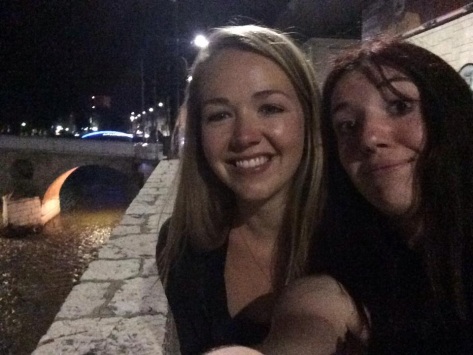Monday 23rd June, 2014

Over today and tomorrow I do two tours, the first is a driving tour organised through my hostel (€25) that takes us all around the city, the second is a free (although it is expected that you tip) walking tour of the city. Throughout these two days my knowledge of all things Bosnian history and war takes shape. I want to record here all the things I’ve learned from the guides, including the guide in Mostar.
- Bosnia was originally part of the Ottoman Empire, which explains half of the architecture in the old town of Sarajevo.
- 40 years prior to WW1 the Ottomans relinquished the land to the Austro Hungarian empire, knowing that they wouldn’t have been able to keep it if it came to a war.
- For these 40 years B&H was under Venetian rule, which explains the other half of the architecture. There is one point in the city (pictured below) marked by a compass where if you look one way down the street (east or west, can’t remember which), all you see is Ottoman architecture and if you turn 180 degrees you will only see Venetian architecture.

- To assuage the locals and to test new technologies, the rulers implemented trams and electric lights among other things. For this reason Sarajevo was one of the more modern European cities at the turn of 20th century.
- The Austro Hungarians lost the war. The Serbs, on the winning side, formed Yugoslavia which included B&H, Slovenia, Hungary, Macedonia, Montenegro, Bulgaria and Albania. This was initially ruled by a Serbian king.
- After WW2 the monarchy was abolished and for a short time Yugoslavia enjoyed a relatively peaceful era under the reign of popular leader Tito. After he died there was no agreement about how to replace him and a near communist regime was implemented with socialist ideologies.
- From this point onwards began the liberation of the Yugoslav nations.
- Due to war times, Bosnia has three main cultural groups living within its borders. The biggest is the Bosnian Muslims (about 45%), the second is the Greek Orthodox Serbs (about 35%) followed by the Catholic Croats. There is an area of Bosnia called the Republic of Serbska where the majority of the Serbs live, this is on land that hugs the northern and eastern borders. However when I asked my Mostar tour guide more specifically about the geographical divisions for the cultural groups he said it’s definitely not as black and white as that, there are communities of each group everywhere. Indeed in Mostar which was the most devastated city in the Bosnian war, some streets are strung with the Bosnian flag and two streets over you won’t be able to see anything except Croatian flags. It was hard for me to understand but he said that some people born here in Croatian areas hate Bosnians. They have grown up in Bosnia but with Croatian customs. He said during the World Cup, some Croats and Serbs (and vice versa of course) will be cheering for the team that is playing Bosnia instead of supporting them. He said a much better division of humankind in his country is those that are united in the vision of moving forward together and those that are living in the past. I will never forget that.

- In Bosnian communities there are two types of flags on display, the first is on a white background with a blue shield and yellow flowers. That is the pre-war flag. The second with the blue background, yellow triangle and white stars is the post war flag, incorporating elements such as the shape of the country, the EU stars (not that they’re a part of the EU) and UN colours. This is the national flag, that all groups agreed upon.
- In 1991 Yugoslavia, predominantly under Serbian rule, had the third biggest army in the world. The Serbs in Bosnia, with the support of Serbia itself, wanted to create one big Serbia and effectively ethnic cleanse themselves of Muslims. Their motto was “unity or death”. They occupied Sarajvo from the surrounding hills for 44 months between 1991-1995 cutting off all water and electricity supplies.

- It is estimated about 30,000 Bosnian women were raped by Serb soldiers during the war. The Serbs had rape houses, a visit to which was said to boost the soldiers’ morale.
- The Bosnians had no army of their own, no trained men, no equipment, nothing. Foreign aid was supplied but a request from the US for arms was rejected.

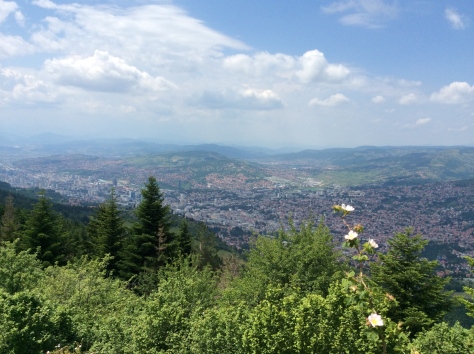
My tour guide for the first day takes us to a number of viewing points all over the city. It seems there are cemeteries on every hill, in every park, just everywhere. There is even a cemetery located on what was a sports training arena, used in the 1984 Sarajevo Winter Olympics. We visit civilian cemeteries, soldier cemeteries, Jewish cemeteries. If nothing else I will remember Sarajevo as the City of Cemeteries.

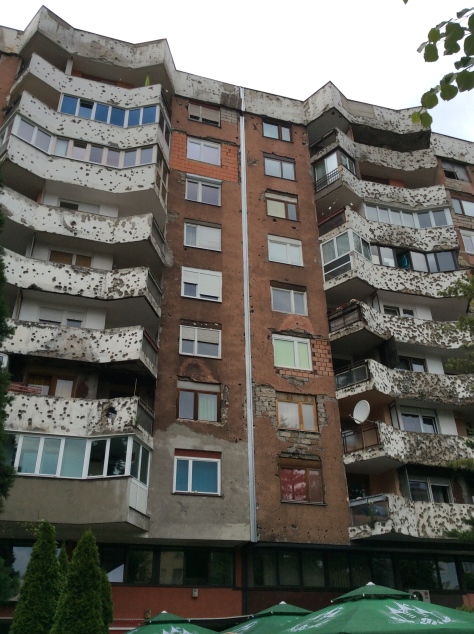
He drives us down what used to be the front line, points out the street known as Sniper Alley and shows photos of the damage done to all significant buildings so we can compare them to the rebuilt versions that we see now. The post office was the first to burn, ensuring communication channels were severed. There was not one building that went undamaged, although the closest one was of course the Greek Orthodox Church. He also showed us a shelled apartment block, one half of which had been fixed up. To my astonishment the other half still had residents living in it, despite the fact that whole chunks of some balconies were still missing, and there wasn’t a handspan that hadn’t been shelled. It was a real eye opener.
Our tour guide shared with us that he was 16 when the war broke out. He wanted to go and fight (18 was the legal age) but his older brother beat him and told him that one sibling was enough to have in the army. His brother died after the first year of war and after that our tour guide lost enthusiasm for the idea. He did tell us though of his memories walking through the famous Sarajevo tunnel which we also visited today.
In 1993 the locals spent four months building the tunnel, with nothing but man power, that started at the airport and went for 800m to the other side of the city. This allowed locals to access the airport for much needed foreign aid that was flown in. Although the US denied Bosnia weapons, they did supply food and other basics. There was a kind of tram track running through the tunnel that allowed transportation of big loads. It was about 5 foot tall maybe 2.5 feet wide. Our guide shared memories of walking the tunnel to fetch supplies for his family. On the return journey he was back to back with other civilians, wading through the water that covered his shoes. On some occasions there would be a hold up which meant they would have to squat for up to 20 minutes at a time, with 40kgs on their backs. Unimaginable to me.
Today the tunnel has been filled in but there remains a 30m stretch for tourists to walk through. It is located next to a mini tunnel ‘museum’ of sorts. It has ‘momentos’ from the war such as clothing (the Bosnians barely had a uniform), weaponry, video footage, written records etc.
One of our last stops, and probably my favourite, is the bob sled track built for the 1984 Olympics. According to our guide it is described by National Geographic as one of the most beautiful but abandoned places to visit. I’m not sure that I would describe it as beautiful but it is well and truly abandoned. The track is now surrounded by forest and is heavily graffitied – in a tasteful way. We walk it’s 1.6km length and notice that not even this has escaped the war. Ironically it was a great shield for the Serbs; the perfect trench actually.
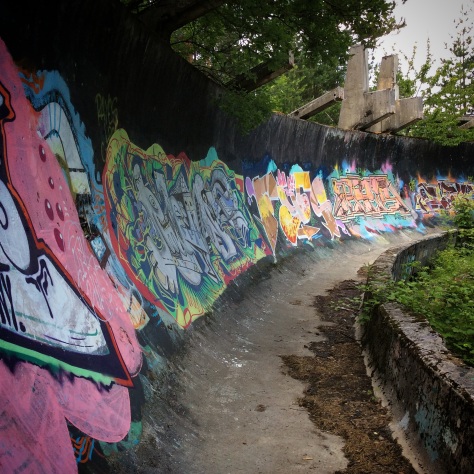
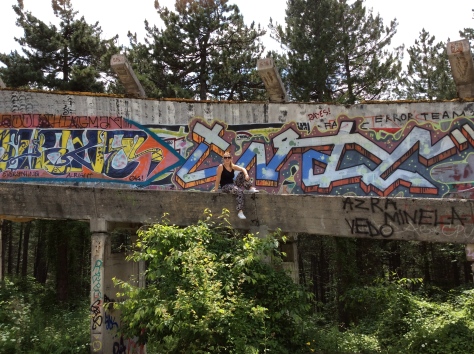
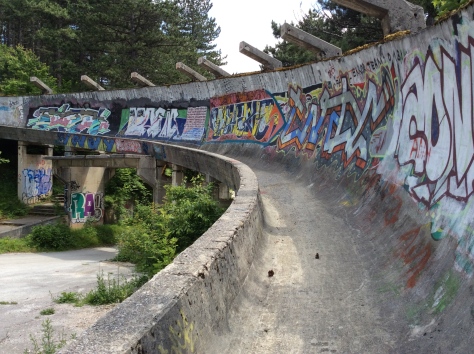

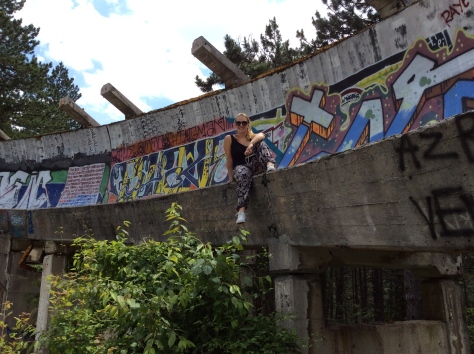
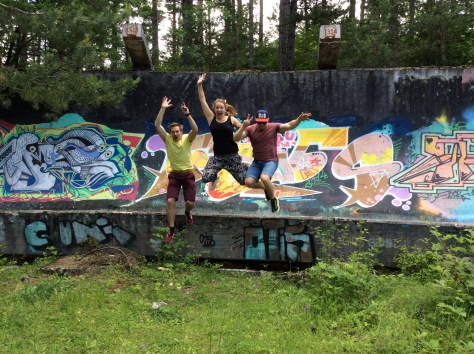
We stop at Biban, a thoroughly recommendable restaurant on a hill with a great view of the city, for a late lunch. By now I have got the impression that like most locals I’ve met, our guide has a complete lack of faith in the government, so much so that he said something that will stick with me forever, “I survived the war but I don’t know if I will survive the peace”. This goes some way in explaining the hopelessness that the citizens feel here. The country really does seem stuck between a rock and a hard place, or maybe a more appropriate adage, stuck between the rigorous demands of the EU, and the fact that the cultural groups are at loggerheads with each other and with a corrupt government. Some interesting facts about modern day Sarajevo and Bosnia:
- The population of Sarajevo is 350,000, it’s the biggest city in Bosnia.
- Unemployment nationwide is 44.8%
- Although in many ways Sarajevo seems to be similar to other European cities (there are some very fashion forward people, I had to resist asking two women on separate occasions if I could take their photo), a more closer look will reveal signs of poverty and poor management, for example The National Museum is closed because of funding problems.
- Income is taxed at 65% yet there is no such thing as the dole or sickness benefit.
- Because of the different cultural groupings the presidency works on an eight month rotational system, a Bosnian, a Croat then a Serb. This is to keep everyone happy and to minimise corruption.
- There are 115 different parties within parliament.
I take myself out for dinner at the same joint I went last night and have a delicious caesar salad. Jennifer has been pumped since yesterday to go to this salsa bar tonight. I think what we expected to happen was kind of like a mini lesson of some kind followed by some social dancing. We also heard it paid to go earlier on a Monday night because it was very popular. So we rock up at 11pm and we are of course the first ones. In retrospect this is a good thing. We tackle the teacher whilst no one is about to judge our non-existent moves and make him give us each a whirl, twice. From about 11.30pm the bar begins to pack out.
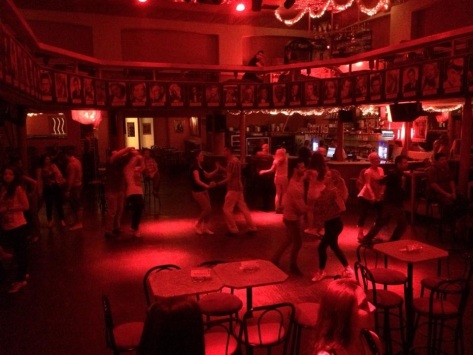
Everyone is a mixture of good, and really fricken good. We sit sipping on our G&Ts, amazed at the talent but saddened at the realisation that there is no way we can get on that dance floor. Just when we decide it’s time to make a dignified exit, a young guy asks me for a dance. More than anything this is a confidence boost. Even though he had only been dancing for two years, he was a good leader and taught me some new moves.
He gives Jennifer a twirl too and she feels the same. He dances with others too but returns to dance with us about four times each. When I am sufficiently sweaty we decide to call it a night. Upon thanking our saviour for the dances and farewelling his friend that we haven’t really talked to he asks us if we we would like to go for a drink. Unsure of the correct protocols around going for drinks with men in strange countries when my better half is a a million miles away but unable to deny the opportunity to properly meet a local and see some more of Sarajevo, plus girlfriended Jennifer is with me so that’s ok right?, we decide to go right ahead. We walk a short distance into the old town and have two tequila shots and a lot of laughs. Our friend is a Bosnian local who has extremely good English and his friend is his cousin, born in Sweden to Bosnian parents who escaped during or after the war. They are 20 and 19 respectively although I had them pegged for mid 20s, never underestimate that facial hair!! Our dance friend is insistent in showing us the best walkable view of Sarajevo by night. Up a huge hill we go and admire the city lights. Very beautiful but I would much rather be in bed by this stage. After dropping a few hints we head back to our joint and exchange thank yous and goodnights.
